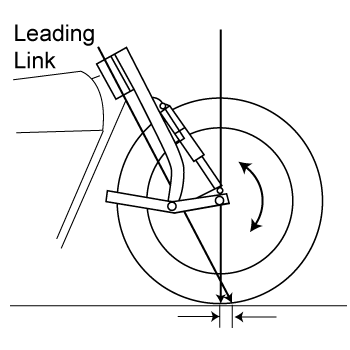Difference between revisions of "Leading Link Forks"
m (Robot: Changing Category:Suspension system) |
|||
| Line 3: | Line 3: | ||
An important early innovation from [[Harley-Davidson]], designed by [[Bill Harley]] in 1907. Until then, [[motorcycle]] pioneers had mainly used unsprung cycle-type forks, which as speeds rose gave a poor ride and handling: they could also fracture. Harley came up with the solution in his final year at university: two sets of fork legs were connected at the bottom by a pair of forged steel links, which formed a pivot joint. Springing came courtesy of four long coil springs mounted inside the moving set of fork legs - the upper springs for load, the lowers for rebound. The wheel's axle was mounted just in front of the forks' lower attachment (hence leading link). For the low-powered machines of the day, they were rigid, had adequate travel, and a constant wheelbase. And they remained Harley-Davidson's standard front suspension for the next 40 years. They were even reintroduced (although in redesigned form) in 1990! | An important early innovation from [[Harley-Davidson]], designed by [[Bill Harley]] in 1907. Until then, [[motorcycle]] pioneers had mainly used unsprung cycle-type forks, which as speeds rose gave a poor ride and handling: they could also fracture. Harley came up with the solution in his final year at university: two sets of fork legs were connected at the bottom by a pair of forged steel links, which formed a pivot joint. Springing came courtesy of four long coil springs mounted inside the moving set of fork legs - the upper springs for load, the lowers for rebound. The wheel's axle was mounted just in front of the forks' lower attachment (hence leading link). For the low-powered machines of the day, they were rigid, had adequate travel, and a constant wheelbase. And they remained Harley-Davidson's standard front suspension for the next 40 years. They were even reintroduced (although in redesigned form) in 1990! | ||
[[Category:Suspension | |||
[[Category:Suspension]] | |||
Latest revision as of 17:25, 26 November 2010
Leading Link forks are a type of motorcycle front suspension. They are often called Springer Forks when they appear on Harley-Davidsons.
An important early innovation from Harley-Davidson, designed by Bill Harley in 1907. Until then, motorcycle pioneers had mainly used unsprung cycle-type forks, which as speeds rose gave a poor ride and handling: they could also fracture. Harley came up with the solution in his final year at university: two sets of fork legs were connected at the bottom by a pair of forged steel links, which formed a pivot joint. Springing came courtesy of four long coil springs mounted inside the moving set of fork legs - the upper springs for load, the lowers for rebound. The wheel's axle was mounted just in front of the forks' lower attachment (hence leading link). For the low-powered machines of the day, they were rigid, had adequate travel, and a constant wheelbase. And they remained Harley-Davidson's standard front suspension for the next 40 years. They were even reintroduced (although in redesigned form) in 1990!
